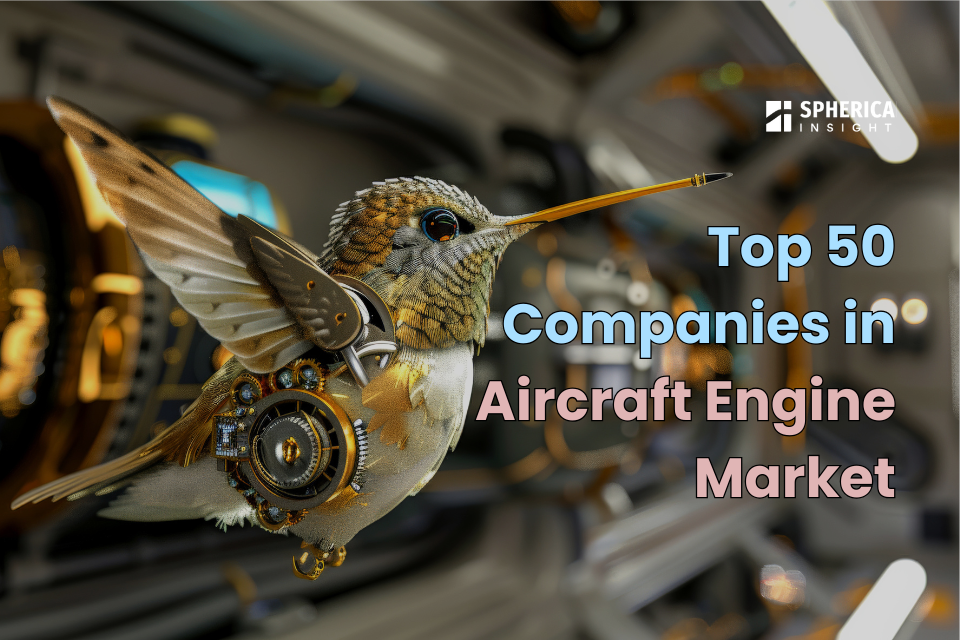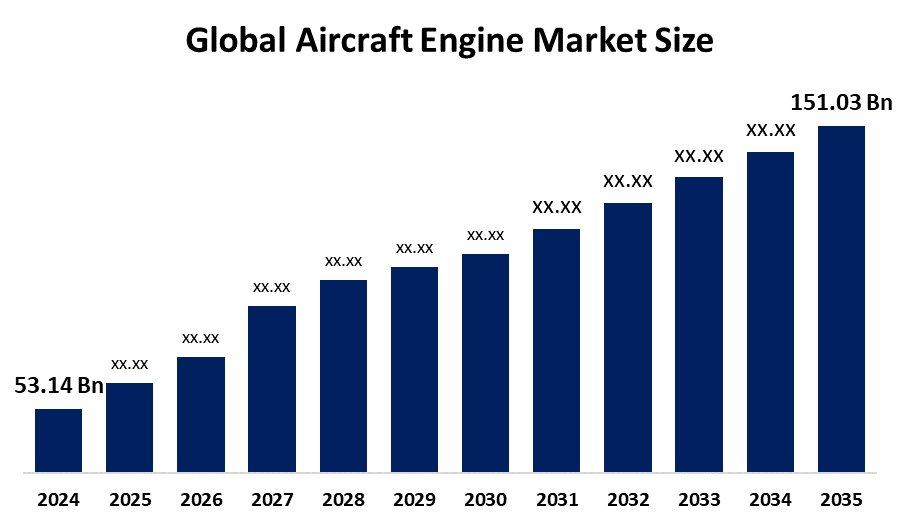
Top 50 Companies in Aircraft Engine Market: Statistics Report Till 2035
RELEASE DATE: Sep 2025 Author: Spherical InsightsRequest Free Sample Speak to Analyst
Description
According to a research report published by Spherical Insights & Consulting, The Global Aircraft Engine Market Size is projected to grow from USD 53.14 Billion in 2024 to USD 151.03 Billion by 2035, at a CAGR of 9.96% during the forecast period 2025–2035. Engines with higher fuel efficiency and lower carbon emissions per flight hour are becoming more and more popular as airlines work to cut operating costs and comply with strict emissions standards.
Introduction
The part of an airplane that provides propulsion when the aircraft is taxing or flying is called the aircraft engine. An aviation engine's main parts are the fan, compressor, combustor, turbine, mixer, and nozzle. In an airplane engine, every part is essential. An aviation engine's fan guarantees the necessary air intake, and the compressor compresses the input air to raise the engine's temperature and pressure. Together with the compressed air, the jet fuel is injected into the combustion chamber. The airplane is powered by a turbine that is rotated by the response. In order to lower the pressure and temperature of the exhaust air produced by the reaction, surplus air from the nozzle is injected into the mixer. Increased passenger traffic worldwide, increased infrastructure investment, regional government initiatives to build up domestic manufacturing capabilities, and global players' intensive R&D efforts to increase aircraft engine operational efficiency and lower carbon emissions are some examples. It is anticipated that the production and supply chain sectors will be crucial in determining how the aviation engine market will consolidate.
Navigate Future Markets with Confidence: Insights from Spherical Insights LLP
The insights presented in this blog are derived from comprehensive market research conducted by Spherical Insights LLP, a trusted advisory partner to leading global enterprises. Backed by in-depth data analysis, expert forecasting, and industry-specific intelligence, our reports empower decision-makers to identify strategic growth opportunities in fast-evolving sectors. Clients seeking detailed market segmentation, competitive landscapes, regional outlooks, and future investment trends will find immense value in the full report. By leveraging our research, businesses can make informed decisions, gain a competitive edge, and stay ahead in the transition toward sustainable and profitable solutions.
Unlock exclusive market insights - Download the Brochure now and dive deeper into the future of the Aircraft Engine Market.
Aircraft Engine Market Size & Statistics
- The Market Size for Aircraft Engine Was Estimated to be worth USD 53.14 Billion in 2024.
- The Market Size is Going to Expand at a CAGR of 9.96% between 2025 and 2035.
- The Global Aircraft Engine Market Size is anticipated to reach USD 151.03 Billion by 2035.
- North America is expected to generate the highest demand during the forecast period in the Aircraft Engine Market
- Asia-Pacific is expected to grow the fastest during the forecast period in The Aircraft Engine Market.

Regional growth and demand
Asia-Pacific is expected to grow the fastest during the forecast period in the aircraft engine market. This is fueled by airlines' quick fleet expansions to keep up with the growing demand for air travel. Major contributors are emerging economies like China and India, which make significant investments in the purchase of new aircraft. Engine efficiency improvements and the construction of regional MRO facilities are two more technological developments that support market expansion.
North America is expected to generate the highest demand during the forecast period in the aircraft engine market. This is due to the need for fuel-efficient engines, fleet expansion, and rising demand for air travel. The region's market is expanding as a result of technological developments, including lightweight materials, sophisticated engine designs like geared turbofans, and improved maintenance procedures. Manufacturers of aviation engines are being forced to engage in engine efficiency innovation due to regulatory changes pertaining to emission reductions and noise abatement, which is improving the region's market outlook.
Top 5 trends in the Aircraft Engine Market
- Advancements in Fuel-Efficient Turbofan Engines
- Adoption of Sustainable Aviation Fuels (SAFs)
- Growth of Hybrid and Electric Propulsion Systems
- Increasing Use of Advanced Materials and Additive Manufacturing
- Expansion of Digital Engine Health Monitoring and Predictive Maintenance
1. Advancements in Fuel-Efficient Turbofan Engines
Modern turbofan engines are being designed to optimize fuel efficiency, reducing emissions and lowering operating costs. Improvements such as higher bypass ratios and advanced aerodynamics extend engine life and increase performance, making them the preferred choice for commercial aviation.
2. Adoption of Sustainable Aviation Fuels (SAFs)
The growing focus on environmental sustainability is driving the integration of SAFs into aircraft engines. These fuels reduce the carbon footprint of flights and comply with increasingly stringent regulatory standards, promoting greener air travel.
3. Growth of Hybrid and Electric Propulsion Systems
Hybrid and electric propulsion technologies are rapidly gaining attention as means to further reduce emissions and noise pollution. Though still emerging, these systems promise to reshape regional aviation and potentially revolutionize engine design for short-haul and urban air mobility markets.
4. Increasing Use of Advanced Materials and Additive Manufacturing
The use of lightweight, heat-resistant materials along with additive manufacturing techniques allows for more efficient, durable, and lighter engine components. These innovations help improve fuel efficiency and reduce overall maintenance costs across engine lifecycles.
5. Expansion of Digital Engine Health Monitoring and Predictive Maintenance
Digital technologies like sensors, IoT, and AI are increasingly adopted for real-time engine health monitoring. Predictive maintenance programs enabled by these innovations improve reliability, minimize downtime, and extend engine service life, optimizing operational efficiency in airline fleets.
Empower your strategic planning:
Stay informed with the latest industry insights and market trends to identify new opportunities and drive growth in the aircraft engine market. To explore more in-depth trends, insights, and forecasts, please refer to our detailed report.
Top 25 Companies Leading the Aircraft Engine Market
- General Electric Aviation
- Safran Aircraft Engines
- Pratt & Whitney
- CFM International
- Rolls-Royce plc
- Honeywell Aerospace
- MTU Aero Engines
- IHI Corporation
- Williams International
- United Technologies Corporation
- Honda Aircraft Company
- Russian United Engine Corporation (UEC)
- Aerojet Rocketdyne
- Kawasaki Heavy Industries
- P&W Canada
- Turbomeca (Safran Helicopter Engines)
- GE Honda Aero Engines
- International Aero Engines (IAE)
- Honeywell Aerospace
- LHTEC (Light Helicopter Turbine Engine Company)
- Avio Aero
- Engine Alliance
- Allison Engine Company (GE subsidiary)
- General Motors Defense (aviation division)
- Rolls-Royce North America
1. General Electric Aviation – Headquarters: Cincinnati, Ohio, USA
General Electric (GE) Aviation is a leading global manufacturer of aircraft engines, powering commercial, military, business, and general aviation aircraft. The company is renowned for its cutting-edge turbofan engines, including the GE9X and GEnx, focusing on fuel efficiency, reliability, and reduced emissions. GE Aviation also pioneers digital engine health monitoring and maintenance solutions that enhance aircraft performance and operational safety. The company invests heavily in research and development to innovate propulsion technologies and sustainable energy sources, positioning itself at the forefront of the evolving aircraft engine market. Its expansive global footprint and collaborations with top aircraft manufacturers underpin its leadership in aerospace propulsion.
2. Safran Aircraft Engines – Headquarters: Paris, France
Safran Aircraft Engines is a prominent player in aerospace propulsion, noted for developing advanced turbofan engines like the LEAP family in partnership with GE under CFM International. The company emphasizes high fuel efficiency, low emissions, and maintenance-friendly designs tailored for commercial airliners. Safran invests in sustainable aviation fuel (SAF) technologies and emerging hybrid-electric systems to align with industry-wide decarbonization goals. With expertise covering engine design, manufacturing, and maintenance, the firm delivers reliable propulsion solutions globally, underpinned by innovative technologies and strong partnerships in the civil and military aerospace sectors.
3. Pratt & Whitney – Headquarters: East Hartford, Connecticut, USA
Pratt & Whitney, a unit of Raytheon Technologies, is a leader in aircraft engines recognized for its revolutionary Geared Turbofan (GTF) technology that significantly improves fuel burn, noise reduction, and emissions. The company’s portfolio serves commercial, military, and business aviation markets. Pratt & Whitney advances engine digitalization and health management through integrated data analytics and predictive maintenance tools. Its focus on innovation, sustainability, and operational cost reduction makes it a key player driving the future of aircraft engine technology, delivering powerplants that meet evolving global aviation demands.
4. CFM International – Headquarters: Cincinnati, Ohio, USA & Paris, France
CFM International is a joint venture between GE Aviation and Safran Aircraft Engines, famed for its CFM56 and LEAP engines widely used in commercial aviation. The company specializes in high-performance turbofan engines that deliver superior fuel efficiency and reduced environmental impact. CFM invests extensively in new materials, advanced aerodynamics, and low-emission technologies to set industry standards. Its engines power a significant share of single-aisle aircraft globally, sustaining CFM International’s position as a market leader and innovator in aircraft propulsion services and aftermarket support.
5. Rolls-Royce plc – Headquarters: London, United Kingdom
Rolls-Royce is a major manufacturer of high-thrust aerospace engines, focusing on wide-body commercial aircraft, business jets, and military platforms. Its Trent series engines are renowned for advanced materials, high bypass ratios, and fuel efficiency. The company pioneers hybrid-electric propulsion research and digital monitoring systems to enhance engine reliability and sustainability. Rolls-Royce’s global service network offers comprehensive maintenance, repair, and overhaul (MRO) solutions, solidifying its reputation as an industry leader in the aircraft engine market through continuous innovation and excellence in propulsion technology.
Are you ready to discover more about the aircraft engine market?
The report provides an in-depth analysis of the leading companies operating in the global aircraft engine market. It includes a comparative assessment based on their product portfolios, business overviews, geographical footprint, strategic initiatives, market segment share, and SWOT analysis. Each company is profiled using a standardized format that includes:
Company Profiles
- General Electric Aviation
- Business Overview
- Company Snapshot
- Products Overview
- Company Market Share Analysis
- Company Coverage Portfolio
- Financial Analysis
- Recent Developments
- Merger and Acquisitions
- SWOT Analysis
- Safran Aircraft Engines
- Pratt & Whitney
- CFM International
- Rolls-Royce plc
- Honeywell Aerospace
- MTU Aero Engines
- IHI Corporation
- Williams International
- Others.
Conclusion
The Aircraft Engine Market Size is poised for dynamic growth driven by several key factors, including the demand for fuel-efficient and environmentally friendly propulsion systems. Technological advancements such as geared turbofans, open rotor engines, and hybrid-electric propulsion are transforming engine performance, reducing emissions and operating costs. Industry focus on sustainable aviation fuels and regulatory pressures further accelerate the shift toward greener technologies. Leading manufacturers are heavily investing in research and development to innovate in materials, digital engine health monitoring, and design optimization.
About the Spherical Insights & Consulting
Spherical Insights & Consulting is a market research and consulting firm which provides actionable market research study, quantitative forecasting and trends analysis provides forward-looking insight especially designed for decision makers and aids ROI.
Which is catering to different industry such as financial sectors, industrial sectors, government organizations, universities, non-profits and corporations. The company's mission is to work with businesses to achieve business objectives and maintain strategic improvements.
CONTACT US:
For More Information on Your Target Market, Please Contact Us Below:
Phone: +1 303 800 4326 (the U.S.)
Phone: +91 90289 24100 (APAC)
Email: inquiry@sphericalinsights.com, sales@sphericalinsights.com
Contact Us: https://www.sphericalinsights.com/contact-us
Need help to buy this report?